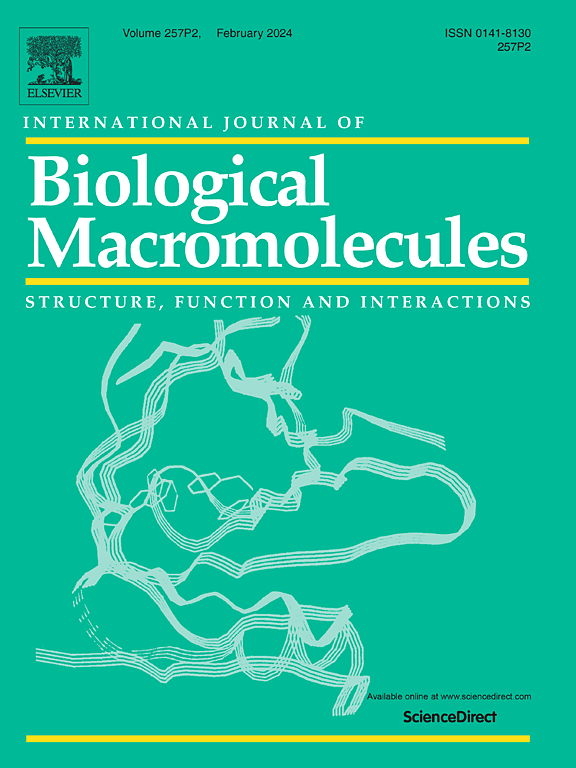Bioelectronics hydrogels for implantable cardiac and brain disease medical treatment application
IF 7.7
1区 化学
Q1 BIOCHEMISTRY & MOLECULAR BIOLOGY
International Journal of Biological Macromolecules
Pub Date : 2025-01-19
DOI:10.1016/j.ijbiomac.2025.139945
引用次数: 0
Abstract
Hydrogel-based bioelectronic systems offer significant benefits for point-of-care diagnosis, treatment of cardiac and cerebral disease, surgical procedures, and other medical applications, ushering in a new era of advancements in medical technology. Progress in hydrogel-based bioelectronics has advanced from basic instrument and sensing capabilities to sophisticated multimodal perceptions and feedback systems. Addressing challenges related to immune responses and inflammation regulation after implantation, physiological dynamic mechanism, biological toxicology as well as device size, power consumption, stability, and signal conversion is crucial for the practical implementation of hydrogel-based bioelectronics in medical implants. Therefore, further exploration of hydrogel-based bioelectronics is imperative, and a comprehensive review is necessary to steer the development of these technologies for use in implantable therapies for cardiac and brain/neural conditions.
In this review, a concise overview is provided on the fundamental principles underlying ionic electronic and ionic bioelectronic mechanisms. Additionally, a comprehensive examination is conducted on various bioelectronic materials integrated within hydrogels for applications in implantable medical treatments. The analysis encompasses a detailed discussion on the representative structures and physical attributes of hydrogels. This includes an exploration of their intrinsic properties such as mechanical strength, dynamic capabilities, shape-memory features, stability, stretchability, and water retention characteristics. Moreover, the discussion extends to properties related to interactions with tissues or the environment, such as adhesiveness, responsiveness, and degradability. The intricate relationships between the structure and properties of hydrogels are thoroughly examined, along with an elucidation of how these properties influence their applications in implantable medical treatments. The review also delves into the processing techniques and characterization methods employed for hydrogels.
Furthermore, recent breakthroughs in the applications of hydrogels are logically explored, covering aspects such as materials, structure, properties, functions, fabrication procedures, and hybridization with other materials.
Finally, the review concludes by outlining the future prospects and challenges associated with hydrogels-based bioelectronics systems.

生物电子学水凝胶在植入式心脑疾病医学治疗中的应用。
基于水凝胶的生物电子系统为即时诊断、心脏和大脑疾病的治疗、外科手术和其他医疗应用提供了显著的好处,开创了医疗技术进步的新时代。基于水凝胶的生物电子学的进展已经从基本的仪器和传感能力发展到复杂的多模态感知和反馈系统。解决与植入后的免疫反应和炎症调节、生理动力学机制、生物毒理学以及设备尺寸、功耗、稳定性和信号转换相关的挑战对于水凝胶生物电子学在医疗植入物中的实际实施至关重要。因此,进一步探索基于水凝胶的生物电子学是势在必行的,并且有必要进行全面的审查,以指导这些技术在心脏和大脑/神经疾病的植入式治疗中的应用。本文简要介绍了离子电子和离子生物电子的基本原理。此外,还对水凝胶中集成的各种生物电子材料在植入式医疗中的应用进行了全面的研究。分析包括对水凝胶的代表性结构和物理性质的详细讨论。这包括对其内在特性的探索,如机械强度、动态能力、形状记忆特性、稳定性、拉伸性和保水特性。此外,讨论还扩展到与组织或环境相互作用相关的特性,如粘附性、响应性和可降解性。水凝胶的结构和性质之间的复杂关系进行了彻底的检查,随着这些性质如何影响其在植入式医疗应用的阐明。综述还深入探讨了水凝胶的加工技术和表征方法。此外,本文还从材料、结构、性质、功能、制备工艺以及与其他材料的杂化等方面探讨了水凝胶在应用方面的最新突破。最后,概述了基于水凝胶的生物电子系统的未来前景和挑战。
本文章由计算机程序翻译,如有差异,请以英文原文为准。
求助全文
约1分钟内获得全文
求助全文
来源期刊
CiteScore
13.70
自引率
9.80%
发文量
2728
审稿时长
64 days
期刊介绍:
The International Journal of Biological Macromolecules is a well-established international journal dedicated to research on the chemical and biological aspects of natural macromolecules. Focusing on proteins, macromolecular carbohydrates, glycoproteins, proteoglycans, lignins, biological poly-acids, and nucleic acids, the journal presents the latest findings in molecular structure, properties, biological activities, interactions, modifications, and functional properties. Papers must offer new and novel insights, encompassing related model systems, structural conformational studies, theoretical developments, and analytical techniques. Each paper is required to primarily focus on at least one named biological macromolecule, reflected in the title, abstract, and text.

 求助内容:
求助内容: 应助结果提醒方式:
应助结果提醒方式:


